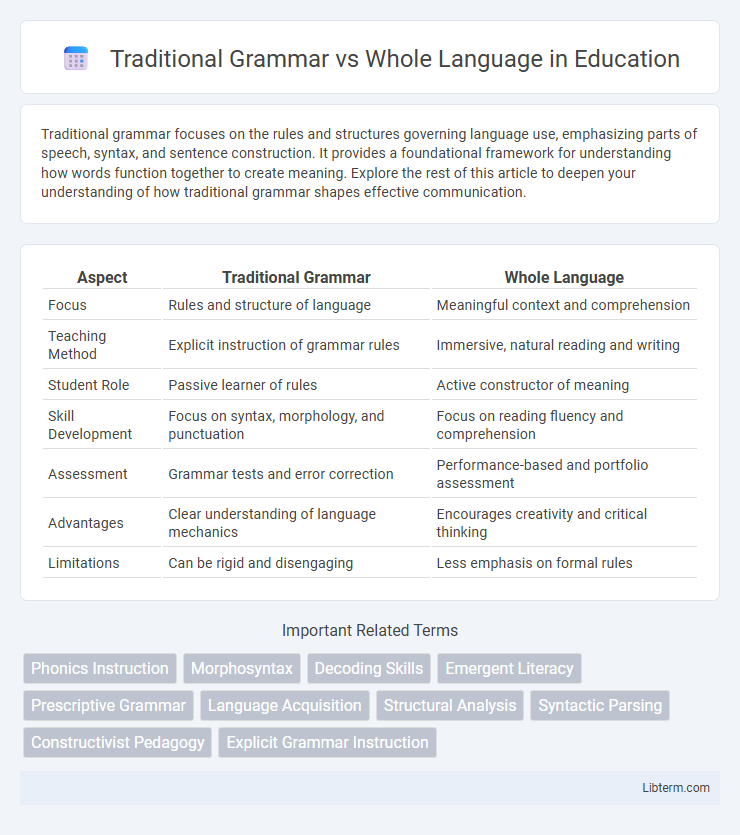Traditional grammar focuses on the rules and structures governing language use, emphasizing parts of speech, syntax, and sentence construction. It provides a foundational framework for understanding how words function together to create meaning. Explore the rest of this article to deepen your understanding of how traditional grammar shapes effective communication.
Table of Comparison
| Aspect | Traditional Grammar | Whole Language |
|---|---|---|
| Focus | Rules and structure of language | Meaningful context and comprehension |
| Teaching Method | Explicit instruction of grammar rules | Immersive, natural reading and writing |
| Student Role | Passive learner of rules | Active constructor of meaning |
| Skill Development | Focus on syntax, morphology, and punctuation | Focus on reading fluency and comprehension |
| Assessment | Grammar tests and error correction | Performance-based and portfolio assessment |
| Advantages | Clear understanding of language mechanics | Encourages creativity and critical thinking |
| Limitations | Can be rigid and disengaging | Less emphasis on formal rules |
Introduction to Traditional Grammar and Whole Language
Traditional Grammar emphasizes explicit instruction in syntax, morphology, and punctuation rules to develop writing and reading skills, focusing on parts of speech and sentence structure. Whole Language promotes immersive reading experiences, encouraging students to derive meaning through context, phonics, and literature, fostering natural language acquisition. This approach supports integration of speaking, listening, reading, and writing within authentic literary environments.
Historical Background and Development
Traditional Grammar, rooted in classical education dating back to ancient Greece and Rome, emphasizes explicit instruction in syntax, morphology, and the formal rules of language structure. Whole Language emerged in the late 20th century as a response to traditional methods, promoting natural language acquisition through immersion, context, and meaning-focused reading experiences. The development of Whole Language drew from constructivist theories and societal shifts towards holistic education, contrasting sharply with the prescriptive nature of Traditional Grammar.
Key Principles of Traditional Grammar
Traditional Grammar centers on the systematic study of sentence structure, emphasizing parts of speech such as nouns, verbs, adjectives, and their syntactic functions. It prioritizes prescriptive rules, including subject-verb agreement and correct punctuation, to ensure standardized language use. This approach supports explicit instruction in grammar rules, helping learners understand sentence construction and grammatical accuracy.
Core Concepts of the Whole Language Approach
The Whole Language approach emphasizes meaning-making through rich, authentic texts, promoting literacy as a natural, integrated process of reading, writing, listening, and speaking. It prioritizes context and comprehension over isolated phonics drills, encouraging students to construct understanding by engaging with complete texts. This holistic strategy fosters motivation and critical thinking by connecting language learning to real-world experiences and student interests.
Differences in Teaching Methods
Traditional Grammar emphasizes explicit instruction in syntax, morphology, and sentence diagramming, focusing on rules and formal correctness. Whole Language centers on contextual, immersive reading and writing experiences, promoting comprehension and meaning-making through authentic texts. The former relies on teacher-led drills and analysis, while the latter encourages student-driven exploration and holistic language use.
Impact on Student Literacy and Comprehension
Traditional Grammar instruction emphasizes explicit teaching of rules and structure, which enhances students' understanding of syntax and improves their ability to decode complex texts, leading to stronger literacy foundations. Whole Language approaches prioritize contextual reading and meaning-making, fostering engagement and comprehension by encouraging students to derive meaning from authentic literature and real-world language use. Research indicates that a balanced integration of both methods supports improved student literacy and comprehension by combining rule-based skills with meaningful context.
Advantages of Traditional Grammar
Traditional grammar provides a structured framework that enhances students' understanding of sentence construction and language rules, promoting accuracy in writing and speaking. Its systematic approach aids in identifying parts of speech and grammatical functions, which supports clearer communication and effective editing skills. This method also reinforces language consistency and precision, essential for academic and professional proficiency.
Benefits of the Whole Language Approach
The Whole Language approach promotes reading comprehension and critical thinking by encouraging students to engage with authentic texts and meaningful context, enhancing vocabulary growth and fluency. It supports individualized learning pace and nurtures a love for reading through integrated language experiences rather than isolated drills. This method fosters motivation and confidence, leading to improved literacy skills and long-term academic success.
Criticisms and Challenges of Each Method
Traditional Grammar faces criticism for its rigid focus on syntax and rote memorization, which can stifle creative language use and fail to engage diverse learners. Whole Language is challenged for its lack of systematic phonics instruction, potentially hindering foundational decoding skills essential for reading proficiency. Educators often debate the effectiveness of balancing explicit grammar rules with contextual language immersion to address varied student needs.
Integrating Traditional Grammar and Whole Language in Modern Classrooms
Integrating traditional grammar and whole language approaches in modern classrooms enhances language acquisition by combining explicit rule instruction with meaningful context-based learning. Teachers can employ structured grammar lessons alongside immersive reading and writing activities to foster deeper comprehension and communication skills. This balanced method supports diverse learning styles, improving grammatical accuracy and fluency simultaneously.
Traditional Grammar Infographic

 libterm.com
libterm.com